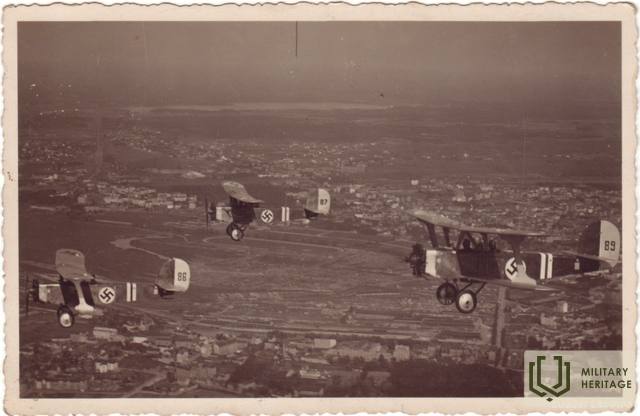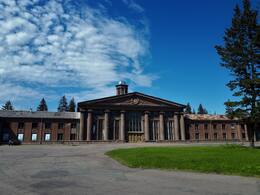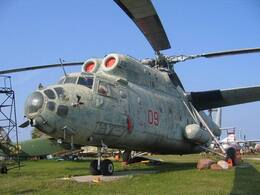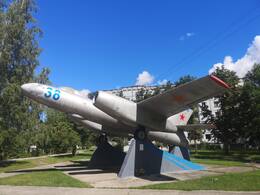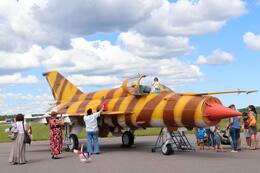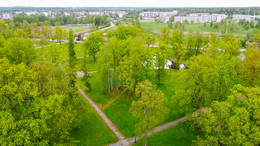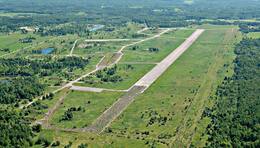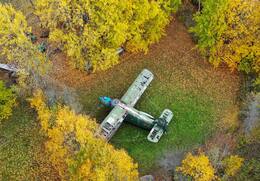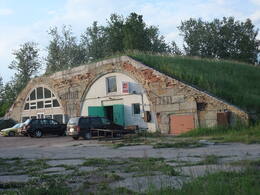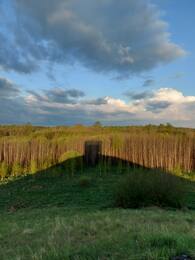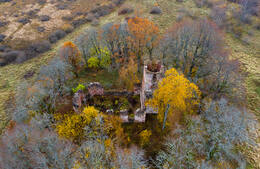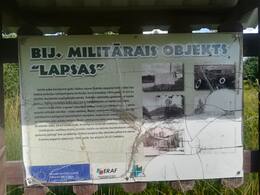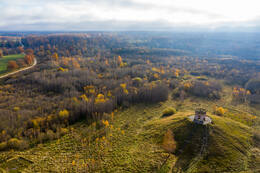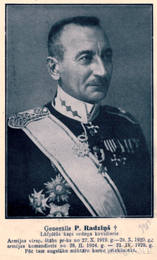Military aviation
I World War I, I Wars of Independence, Independence of the Baltic States, II World War II, IV Soviet Occupation, Restored Independence
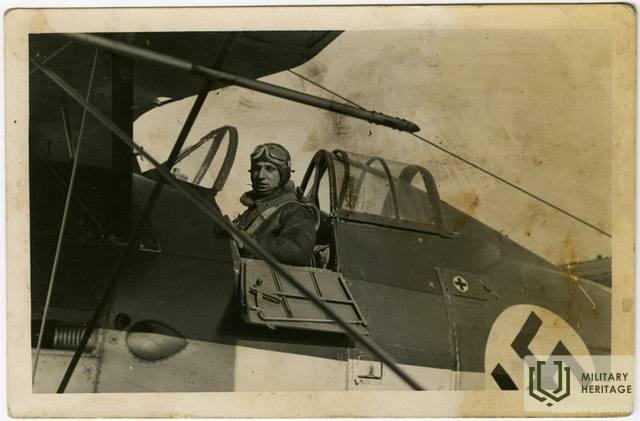
After the proclamation of the state of Latvia in early December 1918, the formation of the Latvian Armed Forces began.
On June 7, 1919, the Latvian Armed Forces Aviation Park was founded (motto — "Everything for Latvia!"), with Alfred Valeika as its first commander. In 1921, the Aviation Park was transformed into an Aviation Division, and on September 18, 1926 — into an Aviation Regiment.
From 1919 to 1940, the Latvian military aviation became the strongest in the Baltic states. At that time, the Latvian aviation had aircraft built at its own factory VEF and in the workshops of the Liepāja military port. There were also aircraft from Europe, mainly from England. The aviation regiment consisted of fighter squadrons, reconnaissance aircraft squadrons, a naval aviation squadron and an aviation school unit, which trained pilots and specialists for all necessary services. In 1939, the Aviation Regiment consisted of: regiment headquarters in Riga, 8 operational squadrons (60 aircraft, 120 pilots and 80 specialists), a Military Aviation School, repair shops, and a supply depot.
The aviation regiment officially ceased to exist on December 25, 1940, after the occupation of Latvia by the USSR.
After Latvia regained its independence, the restoration of the Latvian Defence Forces also began. On February 24, 1992, the Air and Anti-Air Defence Directorate was established at the Defence Forces Headquarters, which was later transformed into the Air Force Headquarters. On June 17, 1992, the Minister of Defence signed an order on the restoration of the Air Force.
More information sources
Sources:
https://www.mil.lv/lv/vienibas/gaisa-speki
Related objects
Spilve airport
Located in Riga, Pārdaugava, in the Spilve meadows near Iļģuciems.
Spilve is famous in the history of military heritage for the grandiose Battle of Spilve in the 18th century and the Spilve airfield. Starting in the 20th century, it was used for testing aircraft, but during World War I it became a witness to the history of Latvian aviation.
During World War I, the Spilve meadows were used by the Russian army's air force for the purposes of fighting the German army. With the creation of Latvia, the airfield became the country's most important air force base and a training ground for pilots. The airfield's previous names were "Spilves Air Port" or "Riga Air Port", later "Riga Central Airport". It was the main airport in Latvia until the opening of the airport "Riga" in 1975.
Perhaps the Spilve airfield near Riga and the dream of reaching for the stars have contributed to the impressive achievements of many Latvian pilots. Perhaps, however, the beginning of Latvian aviation is much older and can be found in Priekule, where a Latvian blacksmith Zviedris made a flight from a church tower with a homemade device.
Today, the Spilve airfield is still in operation. You can see the airport building, built in 1954, which embodies the Soviet classicism or “Stalin Empire” style.
Sources:
Irbītis, K. Latvian aviation and its pioneers. Riga: Zinātne, 2004.
Brūvelis, E. History of Latvian Aviation: 1919-1940. Riga: Zinātne, 2003.
Official website of the state agency "Civil Aviation Agency". Available: https://www.caa.gov.lv/lv/latvijas-aviacijas-vesture-isuma [accessed 22.02.2021].
Riga Airmuseum (Riga Aviation museum)
The Riga Air Museum is located in Skulte village, Marupe municipality, in the territory of Riga Airport, next to the aircraft observation area. It is a privately made tourist attraction that opened in 1997. It has taken more than 50 years to create this collection. Aviation equipment has been gathered from Latvia, Russia, Poland, Ukraine, the Czech Republic and the USA. It is one of the largest and most valuable collections in Europe. The idea of a Latvian Aviation Museum was conceived at least 80 years ago. The history of Latvian aviation dates back to the time when the world's first aircraft were being developed. Latvian pilots were among those who participated in achieving many world records. After World War I and the Latvian War of Independence the Latvian Army started to form an air force, and there was a need to preserve historical evidence. In the 1930s, there was an opportunity to start work on creating a museum. It already had acquired some particularly valuable historical items in its collection. World War II thwarted this project and the collection was lost. Nowadays there are about 40 aircraft objects, mainly manufactured in the Soviet Union. And the exposition gives an insight into the history of Soviet aviation.
Skulte airplane IL-28
Located in the village of Skulte in Mārupe municipality, near Riga International Airport.
Skulte was one of the model villages created for Soviet military personnel. An aviation unit was located there, which carried out the bombing of Berlin and other cities in 1941, and also participated in the occupation of the Baltic States. In 1978, an environmental object - an IL-28 aircraft - was installed there to highlight the merits of Soviet Army pilots in World War II.
After the war, the Soviet Union continued its active armament policy. The IL-28 was the first, most widely produced Soviet jet bomber. The first serial atomic bomb, the RDS-4 ("Tatyana"), was dropped from the same model in 1953 to test the army's ability to launch an attack after a nuclear explosion. The aircraft had various modifications. During tests, it reached a speed of 906 km/h, carrying several tons of cargo and making a flight of 2,445 km. It was piloted by a crew of 3 people.
The plane is not only a witness to military heritage, but also a symbol of ideology. In 2010, to celebrate the victory of the Soviet Army over Germany, the plane was restored. There have also been several unsuccessful attempts to dismantle it as an object glorifying the Latvian occupation regime. This was successful in 2022, when the plane was moved.
Currently, the aircraft can be viewed nearby at the Riga Aviation Museum in Skulte, as well as get an idea of the village built for Soviet Army military personnel.
Aviation Museum “SKY ZOO”
The Aviation Museum “Sky Zoo” is located in Smārde parish, Tukums municipality, in the territory of Jūrmala Airport that was once the Tukums Military Airfield. The exhibit includes aircrafts YAK-40, AN-2, SU22M4, PZL TS-11 Iskra and a helicopter MI-24. Tour of the airfield includes hangars, caponiers and engineering equipment. The airfield was used by both the German and Soviet armies. During the Soviet occupation it was one of the most important military airfields in the territory of Latvia. The fighters stationed there were intended to attack enemy ships and bomb coastal fortifications. On the night of 9 November 1975, a battle alarm was received at the Tukums airfield – there was enemy warship in the territorial waters of the Soviet Union (in the Gulf of Riga), and it had to be destroyed. Several planes took off from Tukums. However, it turned out that it was the Soviet naval warship ‘Storozhevoi’ (Guardian) on which an armed mutiny against the existing Soviet regime took place. When the planes reached the warship, the battle was still ongoing. Later the rebel leader Valery Sablin, a Soviet naval officer, was wounded and the mutiny ended. He was sentenced to death for treason. This was one of the most dramatic events showing the discontent with the regime and marking the approach of its collapse.
Latvian Military Aviation Airport
Located in the territory of Vecgulbene Manor - in the historical center.
In the interwar period, Gulbene was home to a Latvian army garrison, where the 7th Sigulda Infantry Regiment battalion was stationed. In the mid-1930s, the creation of a military aviation base began, because for the successful operation of military aviation, an extensive network of airfields must be ensured even in peacetime. Airfields are especially important in places where important railway and road junctions have been established. On November 11, 1935, construction of a military airfield began here. In 1937, a newly formed Aviation Regiment unit was stationed in Gulbene, which became the 6th reconnaissance squadron of the Latgale Division, increasing the number of army units near the eastern border of Latvia.
The Orangery building is visible.
Vaiņode air base
Vaiņode airfield still has 16 Soviet-era aircraft hangars and an 1800 m section of the once 2500 m long runway. The airfield can only be visited with a previous booking. Vaiņode airfield was established during the Latvian independence as one of the cradles of Latvian aviation and was later one of the largest military airfields in the Baltic States. In 1916, two hangars for German Army airships were built. Airships were used to gather intelligence and bomb the positions of the Russian Army. Later the city of Riga bought the airship hangars and used their roof structures to build the pavilions of the Riga Central Market. In May 1940, the 31st Fast Bomber Aviation Regiment of the Red Army moved to Vaiņode, and the construction of a standardized concrete slab runway began. At the end of the summer of 1944 the partially completed airfield was used by various German aviation units, however, at the end of World War II, the same airfield was used by the Red Army aviation units fighting the German Army group called ‘Kurzeme’. After World War II the Soviet Air Forces were stationed in Vaiņode until 1992.
Kurzeme fortress museum in Zante
Will be open from May 1st.
Rumbula Air Base
Located in the southeast of Riga, in Rumbula, between Maskavas Street and the Daugava River.
Rumbula was home to a Soviet Army Air Force airbase and a civilian airport alongside Riga's main airport in Spilve. Both airports existed until the opening of Riga Airport. Before World War II and the occupation of Latvia, Rumbula was home to an airfield for the Latvian Army Aviation Regiment.
After World War II, the Soviet Union began producing jet-powered aircraft, which required longer and smoother runways. Old airfields were expanded and new ones were built. The changing weather conditions in the Baltics and the short flight time of the first jet aircraft were the reason for the creation of many backup airfields. The noise of jet aircraft caused dissatisfaction among the residents of Riga, because the military airfield was located too close to residential areas and could create dangerous situations. In 1973, it was closed and the Lielvārde airfield was built in its place, to which combat aircraft were transferred. Shortly before the closure, an international scandal broke out. A US Air Force officer, who was one of the military attaches in Moscow, was beaten there. He was allegedly attacked by 14-20 airport employees who suspected that the airfield was being photographed.
Today, you can visit the abandoned airfield area.
Soviet air force target firing ground in Zvārde
Zvārde landfill is located in Zvārde municipality, Saldus region. It is a former military aviation training ground of the USSR, covering more than 24 000 hectares.
The territory of the former airfield is home to several sites: the Officers' Kurgan, the ruins of the Zvārde and Ķērkliņi churches, the Rīteļi cemetery, the former army base "Lapsas", and others. Until the Second World War, the site of the observation tower was home to the "Vairogi" house. During the construction of the polygon, what was left of the farm - walls, the remains of the apple orchard, and part of the ruins of the Veczvārde manor - was piled together to form a mound and the observation tower was built on it. It was used as an observation point for coordinating the army's training manoeuvres. This place is popularly known as Kurgan. The mound overlooks the former training ground and the wooded areas of Zvārde Nature Park and Nature Reserve. A good place for bird watching. The surroundings of Kurgāns are not landscaped.
Ruins of Ķērkliņu church
The ruins of the Ķerkliņu Church are located about 5 kilometres north-west of Kokmuiža, near the Ķerkliņu Lake. The church was built in 1641 by Heinrich von Dönhoff (Derkarth), the owner of the Ķerkliņi manor. The original wooden church was replaced by a stone building, under which tombs were built for the dead of the Dönhof and later Kleist families. The tombs were already destroyed during the 1905 riots, but in 1949 the coffins were moved from the tombs to the church. The church was an example of the Kurzeme Baroque style - its carvings were made by the Kuldīga - Liepāja woodcarvers. Although the owners of the manor and the church were at various times plagued by financial problems, the church underwent several reconstructions during its existence. It also suffered during the First World War, after which the parish rebuilt the stonework in 1929 and added an organ in 1934. Unfortunately, the church was damaged during the Second World War and much of it was lost, so it is to be commended that before the church was rebuilt in 1933, many unique pieces of Baroque sculpture were photographed, inventoried and even ended up in the archives of the Monuments Board. With the establishment of the landfill and the eviction of the inhabitants, the church was never restored. Today, the church walls and tower are visible.
Zvārde shooting range and former Soviet military base "Lapsas"
The landfill's service base is located approximately 2 kilometres east of Striķu Manor, on the Saldus-Auce road. The former Soviet Military Aviation Target Range (military unit No 15439) in Zvārde is located south of Saldus. The territory of the airfield is home to several sights - the ruins of Zvārde and Ķerkliņi churches, the ruined Rīteļi cemetery, the observation post of the airfield, the so-called "Officers' Kurgan" and the former airfield personnel base and shooting range "Lapsas".
The Zvārde air target range required a unit of approximately one company to service the air target range - to install targets, repair damage, guard the air target range and coordinate air flights. It was based on the site of the house called "Lapsas" until the Second World War. With the construction of the airfield, barracks, transport sheds, a flight control tower and a firing range for training personnel were built.
After Latvia regained its independence, the Zvārde Defence Forces Training Centre operated here, but since 2007 the site has been owned by the municipality and leased by several hunting collectives. The former barracks house an exhibition on the history of Zvārde parish.
Soviet Army Observation Tower (Kurgan of Officers)
The "Officers' Kurgan" is located less than a kilometre from the ruins of Zvārde Church. The Kurgan is made of the ruins and remains of the surrounding houses and manor house, which have been bulldozed together. An observation tower was built on the kurgan. According to the inscription, the present tower was built in 1981. The tower was used to record bomb hits. The training bombs had a reduced explosive content, so their hits had to be watched more carefully. Unexploded bombs were neutralized immediately, but not all could be found.
The remains of the tower can be seen here today - the brick walls. As the barrage is relatively high, you can even see the Lithuanian oil refinery in Mažeikiai on a clear day.
Memorial site of General Pēteris Radziņš
Located in Valka parish, driving along the Valka – Rūjiena (P22) road at kilometer 4, turn right, following the signs.
Pēteris Radziņš was born on May 2, 1880 in “Jaunvīndedzēs” of Lugaži parish. He studied at Lugaži parish school, Valka city school and Valka Nelsons real school. He joined the Russian army as a volunteer. In the autumn of 1919, he returned to Latvia and on October 27, he was appointed Chief of Staff of the Supreme Commander of the Army, assuming this position at the moment when the Bermontites threatened Riga. As Chief of Staff, he led all the battles in Riga, Zemgale and Latgale. On February 5, 1920, he was promoted to general.
Nowadays, a memorial stone dedicated to General Pēteris Radziņš (1880 - 1930) can be seen near the family home.
On November 11, 2017, a memorial plaque to Pēteris Radziņš was unveiled in Riga, at the corner of Daugava Gate.
Video: General P. Radziņš memorial event at the Riga Brothers' Cemetery in 2019
Video: On May 2, 2019, on the 139th birthday of General Pēteris Radziņš, a commemorative event was held on the 11th November embankment, near the Presidential Palace, with an honor guard and interested parties surrounding the memorial plaque.
The Valka Museum of Local Lore's exposition "Valka - the Cradle of Latvian Independence" also reflects the life and activities of General Pēteris Radziņš.
In addition to traditional methods of displaying the collection, the exhibition uses interactive multimedia solutions. Information and annotations are translated into Estonian and English.
Zeppelin hangars of Riga Central market
Located in the center of Riga, opposite the Riga International Bus Station, near the Riga Railway Passenger Station.
Riga Central Market is the largest market in Latvia, once considered the best and most modern market in Europe. Its most striking symbol is the market pavilions built in the 1920s, which were originally used for military purposes.
During World War I, the German army established the Vainode airport in Kurzeme, where several airships were permanently stationed. They were oblong balloons filled with gas, with rooms attached to the hulls for transporting passengers and cargo. The control was provided by an internal combustion or electric engine and a wing in the hull. The airships were intended for reconnaissance or bombing the enemy, for example, they carried out an attack on the Russian army seaplane airfield near Roņu Island. It is known that the hangars were called “Walhalla” and “Walther”.
After the Latvian War of Independence, the hangars were dismantled and used for the construction of the Riga Central Market hangars, with the intention of leaving them in their original dimensions. Later, it was decided to use only the upper parts of the hangars.
Today, you can see the metal structures of the German army airship hangar. The market allows you to get acquainted with the evidence of the beginnings of world aviation in a pleasant way. Tour booking: +37167358157; gints.aksiks@rct.lv.
Rīteļi Cemetery
After the airfield was established in this area in 1953 at the request of the USSR Ministry of Defence, the Zvārde Church, the Ķerkliņi Church and the Rīteļi Cemetery were actually located in the centre of the airfield - next to an artificial airfield with access roads and defence positions, which was used as a target by Soviet pilots. Planes flew here from airfields in Latvia and elsewhere in the Soviet Union. In less than 40 years, the church, the cemetery, the former manor house and dozens of surrounding buildings were reduced to ruins. Today, the site is cared for by the Saldus Martin Luther Church. The surrounding area is still contaminated with unexploded ordnance and it can be dangerous to walk off the roads.
Barbarism reached its peak in 1988, when the Rīteļi cemetery with its graves and monuments was bulldozed.
On 21 July 1990, in one of the first actions in which the Latvian population demanded that the USSR army leave the territory of Zvārde, a protest rally was held in Saldus, after which people went to the Rīteļi cemetery. The rally participants were allowed into the landfill site, and they cleaned up the cemetery a bit and dug white crosses.
The landfill continued to be used until 1992 and even as late as March 1992 a plane taking off from Lielvārde crashed in the landfill for unknown reasons. The Latvian Defence Forces started demining the site in May 1993, after the withdrawal of the Russian army. In 2008, Zvārde residents installed a memorial stone "Forgive us for not saving you" in the Rīteļi cemetery.
“Jāzeps Baško – Gaisa Fūrmanis” (“Jāzeps Baško – Air Cabman”) Exhibition of Preiļi Museum of History and Applied Arts
The “Jāzeps Baško – Gaisa Fūrmanis” (“Jāzeps Baško – Air Cab man”) exhibition is dedicated to the 125th birthday of General Jāzeps Baško, the commander of the “Iļja Muromec” squadron and the organiser of the Latvian Air Force, and to the 100th anniversary of World War I.
The exhibition of the museum collection resembles a design object – a model of the Ilya Muromets aircraft that has been reduced in size 6 times, with information in the form of texts and images provided on the model. The exhibition is enriched by exhibits from the collections of the Latvian War Museum and newly acquired information from the Latvian State Historical Archive, the Spilve Aviation Museum and private archives of individuals. Jāzeps Baško is rightly one of the most awarded Latvians and pioneers of global aviation. He set 4 global aviation records flying Ilya Muromets aircraft. His name is inscribed in the Louis Blériot Golden Book in Paris, i.e., the Golden Book of the world’s best aviators. Jāzeps Baško was awarded all orders of the Russian Empire of his time, in Latvia – the Order of the Three Stars, 3rd Class, the Order of Viesturs, 2nd Class, the Home Guard Cross of Merit, as well as the highest awards of Czechoslovakia, Estonia, Finland, and Poland.
He served in the army of the Russian Empire, the Bolshevik Red Army, and, in 1921, he joined the Latvian Army. He retired from service after the occupation of Latvia.
Zokniai airfield
In the part of Šiauliai city called Zokniai, an airfield has been operating since the interwar period, later becoming an airport.
In 1931, it was decided to establish an airfield in Zokniai, the flat fields and gravelly soil were perfect for airplanes. On June 1, the 3rd and 4th reconnaissance squadrons, equipped with LVG C.VI and Albatros C.XV airplanes, were transferred from Kaunas to Zokniai. Hangars, a headquarters building and barracks were built, and Major Leonardas Peseckas became the first commander of the base.
As the capabilities of the Lithuanian military aviation grew, the Zokniai airfield expanded: new hangars, aircraft repair shops were built here, and a bombing range was established near Šilėnai. In 1937, the 5th squadron with Letov Š-20 and FIAT CR20 fighters was transferred to Zokniai, and in 1938 these old fighters were replaced by modern Gloster Gladiators, which achieved excellent results in the Finnish-USSR (Winter) War.
In 1936, during the military reforms of S. Raštikis, military aviation was decentralized, and Zokniai airfield became one of the main military bases of the country. The military aviation forces expanded here, aviation workshops were established, which contributed to the maintenance and repair of aircraft, and later famous designers, such as Bronius Oškinis, worked there. Zokniai airfield became a strategic point, the importance of which grew due to the deployment of nuclear weapons nearby during the Soviet era.
In 2005, at the request of city businessmen, the Šiauliai City Municipality Enterprise “Šiauliai Airport” was established. After Lithuania became a member of NATO, the repair of the airfield runways also began: in 2005, the reconstruction of the backup runway was carried out. Funds were allocated by NATO.
The reconstruction of the main runway was officially completed with the grand opening of the runway on October 26, 2006. The specialists who conducted the flight survey and certification of the reconstructed airfield recognized it as the best in all of Eastern Europe.
Pakri Islands - Soviet aviation target range
The Pakri Islands – Vaike Pakri (Little Pakri) and Suur Pakri (Greater Pakri) – are located in the southern part of the Gulf of Finland, off the town of Paldiski on the northwestern coast of Estonia. These relatively small islands are an example of the historical layering of the military heritage of the Baltic region, especially in the second half of the 20th century, when they were fully militarized as a Soviet aviation training ground.
Historical context and militarization
After the occupation of Estonia in 1940 and the end of World War II, the Pakri Islands came under direct military control of the Soviet Union. They were completely cleared of civilian population – the Swedish and Estonian owners who inhabited the islands were forcibly relocated to the mainland or expelled. This was a typical example of the militarization of the Baltic Sea coast during the consolidation of Soviet power.
The Soviet army created an aviation target range on these islands. Aviation bombers and attack aircraft trained here - aircraft from the continent (especially from the Paldiski base) carried out training bombing, destroying targets located on the islands. Special concrete and metal target imitations were built, as well as observation and command posts. The relief and geographical isolation of the islands made them an “ideal” training range, where the destruction caused by explosions and bombing did not threaten the civilian population and infrastructure on the continent.
Material evidence of military heritage
Today, the Pakri Islands are practically an open-air museum where you can study the military infrastructure of the Cold War. The islands are home to concrete target imitations, bomb craters, fragmented structures, ruins of bunkers and observation posts. Unexploded ordnance is also found in several places - despite periodic mine clearance operations, completely safe movement is not guaranteed. This makes these islands not only an interesting, but also a dangerous place of military heritage.
The islands also illustrate the Soviet military's engineering approach: the construction of the training ground was functional, standardized, and highly durable, with minimal concern for the local environment or cultural heritage. At the same time, it was this massive, often excessive construction that made the Soviet military legacy so enduring – even decades after the training ground was closed, its traces are clearly visible.
Eviction of people and transformation of the cultural landscape
The militarization of the Pakri Islands also meant a complete transformation of the cultural landscape. The local population, who had lived there for centuries (with strong Swedish settler traditions), lost their native environment. The islands became a closed military zone, where civilian life was erased from the map – a typical example of Soviet strategic space.
The time of independence and the tragic incident
As Estonia regained its independence, the Soviet army began to abandon Paldiski and Pakri islands. However, the military legacy did not disappear overnight. In the 1990s, attempts were made to take control of these dangerous and abandoned territories. One of the most tragic episodes occurred in March 1997: a unit of the Estonian police and border guard special forces tried to reach Suur Pakri island by walking along a shallow seabed. Strong winds and icy water made the conditions fatal – several trained men drowned.
Legacy and future
Today, the Pakri Islands are a protected nature reserve. The peculiar irony is that the long military isolation actually helped preserve biodiversity – the departure of humans allowed nature to reclaim the area. However, the risks of contamination from the Soviet landfill and unexploded ordnance remain a real problem.
The Pakri Islands are a vivid example of the problematics of post-military heritage in the Baltics: here, traces of strategic history, forced displacement and loss of identity, ecological degradation and, at the same time, unexpected natural regeneration meet. They are also material evidence of the geopolitical space of the Cold War – of how small islands could become instruments of global military interests and how this past continues to influence our view of landscape and history.
Given the potential danger, it is recommended to visit the Pakri Islands accompanied by a local guide.
Keruspils (Jekabpils) Airport
Krustpils airfield was located near Veselmuiža. A small airfield was already there during the First World War. Its borders were slightly expanded during the Free State of Latvia. The 7th Squadron of long-range reconnaissance was stationed here. One of the commanders was Captain Ēriks Mellups. Around 1935, a new reinforced concrete hangar and two-story barracks were built. At the beginning of the war, the airfield housed aircraft that had been moved from other places and destroyed by German aviation.
During the years of Soviet occupation, the borders of the airfield were significantly expanded. In February 1941, 282 ha of land with surrounding houses were handed over to the Red Army. In April 1941, almost 700 ha were requisitioned. In this way, 152 buildings of surrounding farms were destroyed. Residents of the surrounding parishes within a 50 km zone were involved in the construction work.
In 1974, due to the expansion of the take-off and landing strip, the airfield was expanded by another 44 ha.
Today, Jēkabpils Airfield is an abandoned military airfield, partially privatized with a partially preserved runway and buildings.
Related stories
Riga Central Market hangars
At the time when Riga Central Market was built, it was one of the most modern markets in the world. It was built using the metal structures of the German army airship hangars of World War I as a basis. The author describes the prerequisites for the construction of Riga Central Market and the scope of the construction work, making it one of the most ambitious structures in post-war Latvia and one of the most modern markets in the world.
Aviation Engine Testing Laboratory
During the Soviet era, there was a strange object north of Spilves Street, if memory serves - with two low rectangular "mega-chimneys" built of red brick, from which a jet-like sound similar to the roar of airplane engines could be heard quite often.
Memories of the Spilve Helicopter Base
During the Soviet era, there was a helicopter base in the southwestern part of Spilve Airport. It could be clearly seen from the nearby Kleisti Forest dunes and the Riga-Bolderaja railway branch, which led to the Riga varnish and paint factory.
United Aviation Day - a true national holiday
The narrator describes one of Latvia's most popular and widely attended events – the Aviation Festival in Spilve. He describes the course and scope of the festival. He emphasizes the popularity of aviation in Latvia.
Skulte military bomber
The article in the newspaper vividly demonstrates the situation in modern Latvia, when in many places environmental objects glorifying the Soviet occupation army have been preserved and are even being restored (often at the expense of local governments). The indecision and lack of will of the authorities create long-term, confrontational situations in society. The various monuments, memorials and environmental objects are not perceived as historical or commemorative sites, but as tools that continue the ideology of the Soviet occupation regime.
The secret of Tukums airfield
The Tukums airfield holds a secret that no one has yet solved - is there really a nuclear warhead of a nuclear missile on the airfield territory, which was dug up there by the Russian army's special services after the airfield was abandoned in the 1990s?
Were nuclear warheads buried at Tukums airfield?
Former guard commander Aivars Skurstenis has come forward for an open conversation with the Tukums district newspaper “Neatkarīgās Tukuma Ziņas”. He was once a reserve officer and a field guard, who in 1993 was offered a position as a guard at the agricultural company “Durbe” led by Laimonis Mucenieks. There, he had to guard an office – the Līvāni house. That is how the story begins.
Military airfield near Tukums
The barely visible, grass-covered hangars by the highway to Tukums were home to army fighter jets during the Soviet era. Even in those days, the airfield and hangars were camouflaged, and the uninitiated had no idea about it.
Raid on Vaiņode airfield in 1941
The story of the German air raid on Vaiņode airfield in June 1941
Management of the Tukums reserve airfield in the 1990s.
With the departure of the Soviet occupation troops, the looting of many former military bases began. Soviet soldiers tried to take out as much as possible and leave the infrastructure in a degraded state. After the troops left, civilians continued to loot these bases and exploit the former military infrastructure.
Bombing of Rezekne in 1944
The bombing of Rēzekne took place on Easter 1944, and as a result, a large part of the city's buildings were destroyed and dozens of civilians were killed, while thousands more were left homeless. The people who experienced these events firsthand and can tell us about them were only children at the time. The author of this story is one of them.
Pranks and games with military ammunition
After World War II, the land of Latvia was full of physical remnants of war. It was a large number of shells, unexploded mines and simply cartridges. Even now, especially in places where active war activity took place, unexploded mines are found, which is a great rarity, while in the post-war years these shells were a part of everyday life for residents in forests and even in yards, and even children's toys.
Soviet aircraft bomb Riteli Cemetery
The Riteli cemetery was actually located in the centre of the target area. The locals could only watch as they were destroyed.
Zvardineka's childhood in the shadow of bomb explosions - Polygon Summers
Spending my childhood near the Zvārde target range, under the sounds of explosions and flying jet planes, but still sometimes on weekends I could enter the range. After the Soviet army left, the land was strewn with bomb craters and many explosive objects, not only from the range times, but also from World War II
A slanderer's childhood in the shadow of bomb explosions - Phosphorus capsules
Spending my childhood near the Zvārde target range, under the sounds of explosions and flying jet planes, but still sometimes on weekends you could enter the range. After the Soviet army left, the land was strewn with bomb craters and many explosive objects, not only from the time of the range, but also from World War II. The boys especially liked to burn phosphorus capsules ...
Zvardineika's childhood in the shadow of bomb explosions - the downed plane
The landfill continued to be used until 1992, and even in March 1992, an airplane taking off from Lielvārde crashed in the landfill territory for unknown reasons.
Zvardineika's childhood in the shadow of bomb explosions - the downed plane
The landfill continued to be used until 1992, and even in March 1992, an airplane taking off from Lielvārde crashed in the landfill territory for unknown reasons.
The story of Cīrava airfield
Cīravas airfield – established during World War II, used as a DOSAAF airfield by the Soviets, currently used for agricultural purposes and recreational trips, and Soviet-era aircraft can be viewed in the hangar
Mig-27D aircraft crashed at Zvārde training ground and in Lēdurga
In early 1992, two Soviet-made Russian "war" planes crashed on one day, 40 minutes apart, under mysterious circumstances, at the Zvārde training ground and in Lēdurgās.
Russian military planes crash at Ledurga and Zvarde training grounds
In early 1992, two Soviet Mig-27 D aircraft crashed on one day under mysterious circumstances, 40 minutes apart, at the Lēdurga and Zvārde training grounds.
About the grave of the downed pilot
In the First World War, new technical means were used on a massive scale (machine guns, poison gas, tanks, submarines, artillery barrage tactics, flamethrowers, combat aircraft), which reached an unprecedented level of human casualties. It is said that the last knightly battles were fought in the air, because mutual respect and unwritten rules reigned among the pilots. At the beginning of the war, when the planes were not yet equipped with weapons and flew on observation missions, the pilots of the opposing sides even greeted each other in the air. Later, however, the opposing side would inform the opposing side about the downed or captured enemy pilots by flying to the enemy airfield and dropping a note in a sandbag or even a report from the captured pilots.




